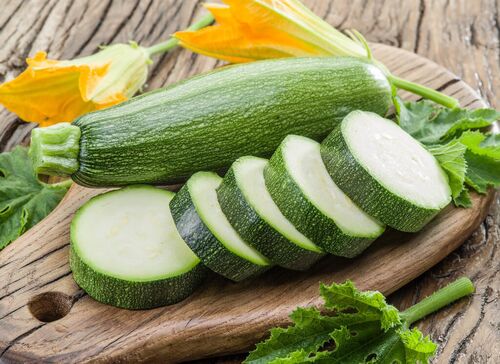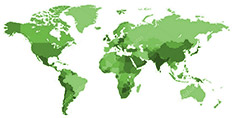Growing Courgette

The courgette ( zucchini ) is a member of the cucumber family and is rich in iron and vitamin C. Although courgette does not have a strong taste on its own, it makes a great addition to a curry or pasta and the zucchini is also healthy!
Sowing courgette
Courgettes are annuals meaning you must sow every spring in order to harvest. However, one plant can yield up to thirty courgettes! Planting distance is 1 metre between plants, this will look enormous but they'll soon fill the space. You could plant some lettuce seedlings in between for a quick salad crop before the courgettes fill the space.
Growing courgettes in pot
Courgette seeds germinate quite easily: it usually takes 7-10 days. For the earliest crops, seeds should be sown in April under glass, but most growers tend to sow in the greenhouse or on windowsill in May. Fill a pot with multipurpose compost. Firm well and press a couple of seeds, on their sides, into the compost. Cover the seeds with compost or vermiculite, which is warm and free-draining and helps stop young seedlings from rotting during cool night temperatures. Keep the soil moist. There are different types of courgette. We have 4 courgette varieties and 3 organic varieties in our range.
View our varieties of Zucchini >
Planting out your courgettes
After the courgettes have been indoors, they can go outside in mid-May, when all risk of frost has passed
because they are not very frost-resistant. If there’s frost coming you can cover the courgette with straw, newspapers or old sheets.
Courgette growing tips
What should you pay attention to when growing or sowing zucchini? They like a warm, sunny spot. They grow best in well-draining soil, enriched with, for example, compost. Too wet soil can cause the plant to rot. Do not pour the water on the plant, but directly on the soil around the plant. Well-fertilized soil ensures a bountiful harvest.
When to sow zucchini?
If you start planting in mid-May, you can harvest them between July and the end of September. Some plants have flowers with both sexes, while others, like zucchinis, have separate male and female flowers. The striking yellow color of courgette flowers attracts bees that carry the pollen from male to female parts. Did you know you can also eat the flowers?! Raw zucchini blossoms are sweet and crisp and make a colorful addition to a salad. You can stuff them with cheese and eat them raw or fried. You can simply pile them onto a plate, drizzle them with olive oil and sprinkle a little sea salt on top. Once flowering is complete, you can expect your first courgette very soon! Check the zucchini every other day.
Harvesting courgette
Ideally, zucchini harvesting will commence when you have fruit that is 6 to 8 inches (15-20 cm.) long. If you pick often, fruit production is hastened, which may or may not be a good thing. If you find that you are drowning in more zucchini than can be reasonably used, leave a few fruit on the plant to slow down production. Fruit should also be dark green (yellow or white depending upon the variety) and firm. If the fruit feels mushy, it’s probably rotting and should be discarded. It's easy to remove the fruit simply by twisting it; the stem usually breaks right off, but sometimes it doesn't, and you better use a knife, cutting off the stem about 1" to 2" from the body of the fruit.
Buying zucchini seeds
We have selected the best zucchini seeds for you. Our range consists of 7 zucchini varieties ( 3 organic ). You can find the information of each product and make a well-informed decision about which courgettes you want to grow. You can also choose to sow different types / colors at the same time!



